There are a million articles and ideas out there on how to help you get rid of your child’s fear of the dark, fear of monsters, or any other nighttime anxiety. Many promise fail-safe and simple solutions that are “guaranteed to work”.
For some children, one or two simple solutions may be enough to get them through a temporary fear. If this is not your child’s story though, you are probably feeling pretty frustrated, tired and confused. (I get it – because none of those easy solutions worked for me and my son either!)
The following is some of the best advice that I have read and used with my own child who has struggled with fear and anxiety – especially around night time and going to bed on his own. I wish this post could offer the guarantee of a fail-safe hack, but from one tired and frustrated parent to another, let me just encourage you to hang in there and keep trying until you find what works!
This post may contain affiliate links
Teach Coping Skills and Practice them Together
Here’s the thing, children aren’t born with the ability to self-soothe. This is something that they have to learn. The good news is that kids are generally quite receptive to learning new strategies to cope – especially when they are fun and engaging. Here are a few ones that work well with calming nighttime anxieties.
- Dragon Breathing: Breathe in through your nose and out through your mouth slowly. As you breathe in imagine that you are breathing in courage and turning yourself into a big strong dragon. As you breathe out, imagine that you are blowing out all of your fear just like a dragon breathes out fire. (You can also find other deep breathing strategies for kids in this article here.)
- 5 Senses Scavenger Hunt: List 5 things you can see, 4 things you can feel, 3 things you can hear, 2 things you can smell, and 1 thing you can taste.
- Use Coping Skills Cards. You can download a free mini-card deck in the Parenting Resource Library or purchase full printable set here. My son keeps these in his nightstand and uses them regularly!
- Practice meditation. (There are many great guided meditations for relaxation and sleep for kids on YouTube or you can find ones to download in Audible.)
- Incorporate positive and encouraging sayings/affirmations into your child’s room through posters and teach them to focus on these sayings, repeating them in their head to distract from scary thoughts. You can use the Make Your Own Affirmation Kit to let your kiddo write and create their own affirmation posters!
- Use a workbook such as The Brave Guide to Being Afraid which provides 10 fun activities, crafts, and exercises that give you a tool to use with your child to help them through their fears. (Learn more here.)
Set a Routine and Stick to It
If you are anything like me, this is one of the most frustrating and difficult to implement strategies. But, a consistent bedtime routine really is a good way to cue the brain into the fact that it is time to go to sleep. Consistency and routine are also crucial tools for fighting anxiety in general. Here is a sample bedtime routine that works well for elementary-aged children.
6: 00 pm Turn off all screens (tv, computers, devices, etc.)
7:00 pm Bath time with calming lavender bubbles.
7:30 pm Jammies and Teeth brushing.
7:30 pm Storytime
7:50 pm Coping Skills Practice (My son loves to do a page out of the Little Brave Guide to Being Afraid right before bed! It really helps him shift his focus from being afraid to being confident and willing to try.)
8:00 pm Tuck-In, Goodnight Hug and Kiss
Use Tools to Help Ease Fears
There are so many products out there that may provide some help for your child. Some good options include nightlights that are portable (for trips to the bathroom), sound machines or white noise machines (this is a favorite of my son’s – it really helps to drown out those scary noises), weighted blankets (make sure you use one for their weight as well as a washable one – like the one in this link.), nighttime story or relaxation apps, and baby monitors or walkie talkies to ease fears of you not being in the room with them.

Understand that Validating their Fear Doesn’t Mean You Are Agreeing with Them
There is advice out there that suggests that you should use logic and reason with your child, explaining that monsters aren’t real or that the dark isn’t really scary because everything is just the same as when the lights are on. This advice, while coming from a good place, is really misguided. It stems from the worry that by validating the child’s fear, it will make it bigger and scarier for the child.
The problem with trying to explain away your child’s fear is that at the moment, the monsters that they are afraid of, are very real to them. Telling them that they are not real, just makes them feel unheard and misunderstood. This often leads to an increase in anxiety behaviors as the child tries to make the adult understand their reality.
Instead of using logic or reason, validate their emotions with the following 2 step process. Start by using reflective listening to validate your child’s feelings. Ask your child what they are afraid of and then repeat back to them what they have said: “I hear you saying that you are really afraid of going to sleep by yourself because the dark feels really scary to you.” Next, give them some control of the situation by giving them a choice: “Would you rather talk more about what is scaring you right now or would you like to work on coming up with a plan to help you be less afraid?”
If your child chooses to continue talking about what they are afraid of, repeat the process with reflective listening and then giving a choice to instill control over the situation. If they choose to come up with a plan, ask them to provide suggestions but have a few ideas pre-thought out in case they need a little guidance.
You can also use a Problem Solving Worksheet when they are ready to come up with a solution. I have a free printable problem-solving worksheet for kids available in the Parenting Resource Library. You can download that by signing up below.
The goal may not be to eliminate the fear but to teach them how to handle the fear and get through it.
Unfortunately, there is rarely a quick and easy solution that will completely eliminate all of your child’s fears. If you can change your goal from fixing the problem to teaching your children to navigate their fears, they will become much more capable as time goes on to face their nighttime fears as well as any other anxiety that crops up for them throughout the rest of their lives.
Here are some ways to teach children to cope with and work through their fears:
- Teach them to be problem solvers so that they feel empowered to create solutions on their own. Using a problem-solving worksheet can be a great way to teach this skill. Download a free problem solving worksheet here.
- Ask them, “what’s the worst that could happen” and have them talk through this thought. This is a great exercise for working through panic. Sometimes it’s the fear of the unknown that is scarier than the actual reality that they are in.
- Teach your child to talk back, out loud if necessary, to their fears. Come up with things that they could say to their fear, whether it is the dark, monsters, or anything else.
- Teach your child to practice coping skills on a regular basis even when they are not afraid. This is the best way to really engrain those skills into them so that they are readily available when needed. The Little Brave Guide to Being Afraid is a great tool for you to use when teaching these skills to your kids!
Look for Every Possibility to Praise and Reinforce Positive Behavior
One final tool that is crucial in helping your child learn to deal with and move beyond their nighttime fears is to notice and praise their efforts and progress. Anytime you see your child using a positive coping strategy, working through a problem on their own, being brave in other areas, etc., make sure to heap on the praise.
Praising your child will help them understand that you see them as capable of solving this problem which goes a long way in combatting the guilt and stress that can come with being afraid of going to bed.
Enlisting the Help of a Professional
If you find that you have tried everything and your child is still really struggling, or if you find that you are still feeling really overwhelmed and unsure of how to help your child, it is time to get professional help. Finding a children’s therapist can be an invaluable tool when dealing with ongoing anxiety and fear. You may also choose to start by talking with your pediatrician to ensure that there are not any health issues that need to be addressed.

